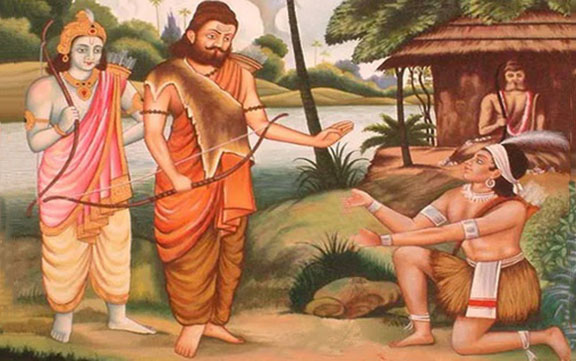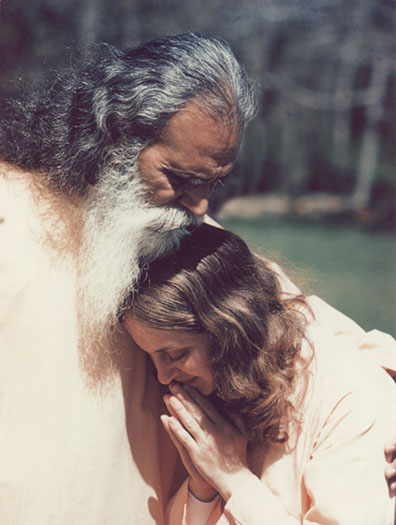
(Photo: Integral Yoga Retreat)
It was in September 1970 that I first met my spiritual master. It was a time when many great Gurus were being drawn to the West, attracted by the awakening aspiration of the youth. Several hundred of us had gathered at a rustic site in the mountains of California for our first spiritual retreat. Sri Swami Satchidananda was to be our guide for this inner journey of discovery.
Every morning and evening, as the mist touched the mountains, he would come and impart the sacred teachings, just as they had been passed from Guru to disciple since ancient times. In the brisk mountain air, we sat rapt in an atmosphere electric with knowledge and power, permeated with peace and love.
For grace is given not because we have done good works, but in order that we may be able to do them. —St. Augustine
On those five precious days, Sri Gurudev, (as we came to call him), presented the teachings of Raja Yoga and changed my life forever. As he spoke, tears filled my eyes. It was if the deepest part of my soul was being watered after eons of drought, and something that had been lying dormant, almost forgotten, was suddenly quickened and awakened.
I had recently graduated from college where I had studied science and philosophy, and found myself with more questions than answers. By the end of the retreat, all those questions had been resolved, and my mind knew peace. His words resonated deep within my heart. It was like hearing that which I had always known to be true, but with a clarity and authority that put all doubts to rest.
The following year, Sri Gurudev returned for a second retreat. He spoke at length about yama and niyama, the first two limbs of Sri Patanjali’s eight-limbed system of Raja Yoga. Yama refers to the Great Vows, five abstinences that all are asked to follow: non-violence, truthfulness, non-stealing, continence or moderation, and non-greed. Niyama refers to five observances for spiritual life: purity, contentment, accepting pain as help for purification, spiritual study, and surrender to the Divine. It was clear from his emphasis that these were the foundation of spiritual life.
His presentation of the teachings fanned the flame of my flickering aspiration, and along with numerous other participants, I requested mantra initiation. Much to my surprise and dismay, he refused my request. I was stunned, confused and didn’t know what to do. Then one day, he recounted the story of Ekalavya, a young hunter boy who wanted to learn archery from Drona, the teacher to the children of the royal family. Drona refused, explaining that certain techniques were given only to the princes, because they were the ones charged with defending the country. They were not to be imparted to an ordinary hunter, who armed with that knowledge, might one day challenge the royal family. Unmoved by Ekalavya’s pleas and promises, Drona remained firm in his refusal to teach him.

(Photo: Ekalavya requesting Drona to be his Guru.)
At first, Ekalavya was very disappointed. But then, he had an idea: “Drona may not want to teach me, but I will learn from him.” In his heart, he took Drona as his Guru. Out of clay, he fashioned a crude image of Drona, placed it on a pedestal, and started meditating on it. He was one-pointed in his devotion and determination. And as he sat there and meditated, all that Drona was imparting to the princes in the forest was revealed to him as well.
The proof came one day when Drona was teaching Arjuna the “multiple warhead” secret. Arjuna was told to take one arrow, repeat certain mantras, aim and shoot. The arrow would then multiply itself into ten arrows and pierce the target in ten places. Simultaneously, Ekalavya received the secret teaching as he was meditating in front of the clay image. As fate would have it, both Arjuna and Ekalvya chose the same wild pig as their target. When they tracked down the pig, it was pierced by twenty arrows. Even though Drona had refused to teach him, Ekalavya had received all the knowledge because of his faith and focus.
Emboldened by the story, I decided to take a similar approach. I summoned my courage and declared to the invisible presence of my teacher, “You may not have accepted me as your student, but I have chosen you as my Guru.” Then, as an offering to my Guru, I resolved to spend the next year working on the precepts of yama and niyama. I would focus on one a month, and just as Gurudev had recommended, if I slipped in my resolve on any given day, I would observe a certain consequence. He indicated that the consequence could be any beneficial practice, like more pranayama, meditation, or selfless service. That way, you would be continually asserting your mastery over the mind.
I was a typical beginner—eager, but clueless as to my capacity. The first precept was non-violence, so I decided to be non-violent in thought, word and deed. Being a beginner, I also chose what seemed to be the most challenging consequence I could imagine: If I failed in my resolve, I would fast for the rest of the day. I sent Sri Gurudev a note telling him of my commitment and began the practice immediately. Needless to say, the part of my mind that did not want to be disciplined was equal to the challenge I had set before it. In the morning, shortly after awakening, my mind would produce a thought that was not in keeping with my resolve, so I would have to fast for the rest of the day. Daily, I struggled with my mind’s resistance and attempts to sabotage my efforts. Determined, I persisted with the practice.

(Photo: Swami Karunananda receives her Guru’s blessing.)
On the last day of the retreat, Sri Gurudev unexpectedly called me to see him. As I approached, it felt like everything that had come before in my life converged to this one moment in time and then came to a standstill. Space and time fell away; all that existed was this extraordinary presence I felt before me. His eyes looked totally black, yet filled with light. They seemed like a portal, through which one could see into the center of the universe. He said nothing, but extended his hand and placed it firmly on my head. I was filled with a power and blessing beyond anything I could conceive. Then, he softly said he would accept me as his disciple. Casually, he indicated that the meeting was over and I returned to the retreat. I believe that one moment of grace shaped and has sustained all my efforts on the spiritual path ever since.
After leaving the retreat, I continued the practice, working on one precept per month for the balance of the year. I learned so much that I decided to have a second go-around. It was time to practice non-violence again, but by now, I was a more seasoned aspirant. I retained the same consequence, but re-evaluated my goal for the month. Whereas before, it was to be totally non-violent on every level, now I wished to set a goal that seemed so easy I wouldn’t have to fast. So, I eliminated trying to control my thoughts; that would definitely be too hard. Next, I eliminated trying to control speech. Even being vigilant with respect to all actions seemed too taxing. So, I kept narrowing the field till, at last, I came to one thing: doors. In the name of non-violence, I wouldn’t slam doors.
This was a moment of stark personal reckoning. I thought I could be totally non-violent in thought, word and deed, only to discover I couldn’t even be trusted to close a door gently. But that month spent trying not to slam doors turned out to be one of the most important steps on my spiritual path. It laid the foundation for all the inner work that has followed. It was meaningful on two counts:
First, it was a good match for my capacity. Previously, I had been trying to fly, when I could barely crawl. No real growth can happen that way. Trying to reach too far too fast is a trick of the mind that can sabotage our efforts. Goals have to be challenging, but doable. If we make the effort, we will succeed. That way we feel a forward momentum; our progress becomes tangible and our confidence grows.
Secondly, spiritual practice was no longer confined to a couple of hours at the beginning and end of the day. I began to see doors everywhere. A sliding window was a door, a lid for a box became a door, even a zipper was a door. Life, itself, became the field for practice and the comprehensive system of Raja Yoga became my roadmap.
About the Author:
 Swami Karunananda is a senior disciple of Sri Swami Satchidananda. In 1975, she was ordained as a monk into the Holy Order of Sannyas. She has had almost 50 years experience teaching all aspects of Yoga and specializes now in workshops, retreats, and teacher training programs that focus on the science of meditation, the philosophy of Yoga, personal transformation, and Yoga breathing techniques for better health and well-being. She developed, and for 30 years has taught, the Integral Yoga Teacher Training programs in Raja Yoga and in Meditation.
Swami Karunananda is a senior disciple of Sri Swami Satchidananda. In 1975, she was ordained as a monk into the Holy Order of Sannyas. She has had almost 50 years experience teaching all aspects of Yoga and specializes now in workshops, retreats, and teacher training programs that focus on the science of meditation, the philosophy of Yoga, personal transformation, and Yoga breathing techniques for better health and well-being. She developed, and for 30 years has taught, the Integral Yoga Teacher Training programs in Raja Yoga and in Meditation.
Swami Karunananda served as president of Satchidananda Ashram–Yogaville in Virginia and in California, as well as director of the Integral Yoga Institutes in San Francisco and in Santa Barbara. She currently serves on the Board of Trustees, and as the chairperson of the Spiritual Life Board at Satchidananda Ashram–Yogaville, Virginia. She is a contributing editor for The Breath of Life: Integral Yoga Pranayama, as well as a senior writer for the Integral Yoga Magazine. In her book, Awakening: Aspiration to Realization Through Integral Yoga, she describes the spiritual path and provides guidance for the journey. This article is an excerpt from her forthcoming book: Raja Yoga Now.

